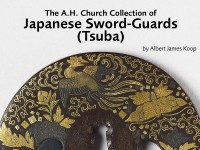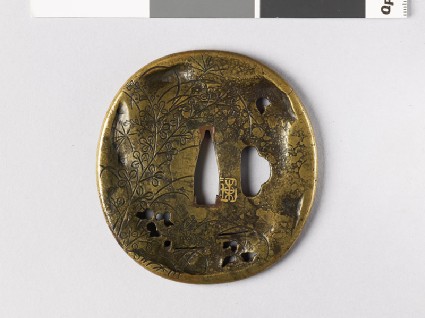The A. H. Church Collection of Japanese Sword-Guards (Tsuba)
An unpublished catalogue of the A. H. Church collection of Japanese sword-guards (tsuba) by Albert James Koop.

Publications online: 1264 objects
Tsuba with plants and landscape scene
-
Literature notes
Very heavily dented on both faces, and the edge hammered up, but all surfaces rounded off and polished, after etching to produce a mottled appearance here and there; small patches of cross-hatch ishime; two or three groups of perforations of irregular shape (water and clumps of leaves?); the front delicately engraved with lespedeza plants and susuki grass; the back more boldly engraved with a Chinese landscape, with buildings, etc., including a man crossing a bridge; the moon's disk encrusted in lead. Signed with a gold-inlaid seal partly cut away: Tōu [Japanese text].
A remarkable piece in thoroughly Japanese taste, reminding one of guards by Umetada Miōju (Group XI). It was acquired from the Hawkshaw Collection (no. 202), in the catalogue of which Mr. Joly placed it in the Umetada section and gave it a 17th-century dating. But it is clearly an archaistic piece by a Yasuchika. -
Details
- Associated place
- Date
- 2nd half of the 18th century
- Material and technique
- sentoku, with cut and filed openwork decoration, hammered-up edge, etched decoration, polished surface (migaki-ji), punched ishime decoration, engraved decoration, and inlaid with lead; tang-hole plugged with soft metal, probably copper
- Dimensions
- 9 x 8.4 x 0.6 cm (height x width x depth)
- Material index
-
processed material › metal › alloy › sentoku,processed material › metal › lead,
- Technique index
-
cut,
- Object type index
-
arms/armour › koshirae › kodogu › tsuba
- No. of items
- 1
- Credit line
- Bequeathed by Sir Arthur H. Church, 1915.
- Accession no.
- EAX.10952
-
Further reading
Koop, Albert James, The A. H. Church Collection of Japanese Sword-Guards (Tsuba), 3 vols (Oxford, Ashmolean Museum, 1929), no. 952
Glossary (2)
sentoku, tsuba
-
sentoku
A kind of brass made from an alloy of copper, zinc, and tin.
-
tsuba
Japanese sword guard.
Location
-
- currently in research collection
Objects are sometimes moved to a different location. Our object location data is usually updated on a monthly basis. Contact the Jameel Study Centre if you are planning to visit the museum to see a particular object on display, or would like to arrange an appointment to see an object in our reserve collections.
Publications online
-

The A. H. Church Collection of Japanese Sword-Guards (Tsuba)
Very heavily dented on both faces, and the edge hammered up, but all surfaces rounded off and polished, after etching to produce a mottled appearance here and there; small patches of cross-hatch ishime; two or three groups of perforations of irregular shape (water and clumps of leaves?); the front delicately engraved with lespedeza plants and susuki grass; the back more boldly engraved with a Chinese landscape, with buildings, etc., including a man crossing a bridge; the moon's disk encrusted in lead. Signed with a gold-inlaid seal partly cut away: Tōu [Japanese text].
A remarkable piece in thoroughly Japanese taste, reminding one of guards by Umetada Miōju (Group XI). It was acquired from the Hawkshaw Collection (no. 202), in the catalogue of which Mr. Joly placed it in the Umetada section and gave it a 17th-century dating. But it is clearly an archaistic piece by a Yasuchika.
Notice
Object information may not accurately reflect the actual contents of the original publication, since our online objects contain current information held in our collections database. Click on 'buy this publication' to purchase printed versions of our online publications, where available, or contact the Jameel Study Centre to arrange access to books on our collections that are now out of print.
© 2013 University of Oxford - Ashmolean Museum

